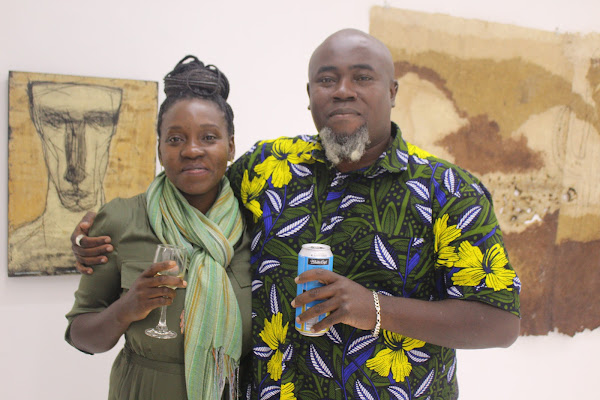Monday, 28 November 2022
POETRY AND PAINT GO TOGETHER AT CIRCLE ART
BY Margaretta wa Gacheru (written 26 November 2022)
Circle Art Gallery has outdone itself with the launch of ‘The Forest and Desert Revisited’ exhibition last Wednesday night.
Curated by the South African architect, researcher, and curator, Michelle Mlati, the show brings to mind the concept forwarded first by the British imperialist Cecil Rhodes who was intent on dominating Africa “from Cape to Cairo” for his empire.
Michelle is no imperialist although she has been intent on capturing some of the finest contemporary artworks “from Cape to Cairo” as seen at Circle Art where she represents the Cape and Souad Abdelrassoul represents Cairo.
In between, her regional focus has primarily been on Sudanese artists whose artworks could correlate in some way with the core concepts found in the poetic tradition and literary movement defined in the Sudanese Forest and Desert School. The main one relates to identity, with the forest representing South Sudan and Africans while the desert represents the North and the Arab. The ideas emerged in the 1960s in the poetry of Sudanese poets and they still resonate for some in literary, social, and political realms today.
But could they be visible in the visual arts as well? This was just one of the questions Mlati addresses in an exhibition which she tells BDLife was collaborative, enhanced through her association with friends from Circle Art and elsewhere.
The other key concept reflected in the show relates to hybridity, or the mixing, blending, and thus breaking down boundaries and constructing new forms of life, literature, and creative expression in visual as well as literary terms.
Hybridity is the key that enables Mladi to explain how two Kenyans, one Ugandan and a Palestinian artist all have relevance in relation to the Forest and Desert School. It’s because hybridity, like cross-breeding, means one can take totally different concepts and blend them together to see what comes out.
Hybridity also enabled her to broaden the scope of the show to examine aspects of color, texture, and technique. It also serves to explains how she can not only correlate poetry and painting, but also break down regional borders and cultures barriers.
There are 11 artists in ‘School revisited’. Seven are Sudanese, two Kenyans, one Ugandan, and one Palestinian.
It’s an eclectic lot, challenging one to see any singularity of focus. But no matter. Color coding can provide an organic clue as to why or what, for instance, Tabitha wa Thuku has in common with Sudanese Salah Elmur or Egyptian Souad. All three lean towards green verdant stories.
At the same time, Elmur epitomizes Mladi’s hidden argument that the binary notions of black sub-Saharan being ‘forest’ and the desert being Arabian no longer apply across the board. For his work contains verdant greens as well as sandy brown hues representing ‘desert’ ideas. And he is not alone. The Ugandan sculptor, paper-maker Sheila Nakitende would have been considered a forest-dweller in days gone by. But the beige-brown bark paper that she has shaped into a tapestry-like textured ‘sculpture’ could have come straight out of the desert color-wise. But on the contrary, she tells BDLife:“Bark cloth is traditionally known in my country as a fabric that one can wear; but I discovered that the cloth could be made into [textured] paper which I have layered.”
The Forest and Desert School itself was started by several Sudanese poets who cultivated conversations about identity, especially as it related to Sudanese society where the tensions between Africans and Arabs led to powerful and passionate poetry that developed into an artistic movement.
“This exhibition started as a conversation with [the Sudanese artist] Abushariaa when I visited his studio in Kampala,” says Mlati who was managing the Afriart Gallery at the time.
“He is the one who spoke to me first about the influence the Forest & Desert School had on many young visual artists. That’s what triggered my curiosity and my research,” she adds.
Ironically, while she proposes breaking down borders between the artists, she also suggests there are three ‘generations’ of Sudanese artists represented in the exhibition. The ‘elders’ include Mohamed Abdella Otaybi and Elmur, while the younger are Tibian Bahari, a Nairobi-based painter and installation artist Reem Aljeally.
In between are Abushariaa, Eltayeb Dawelbait, and Issam Hafiez.
The Egyptian, Ugandan and one Kenyan all are women as are Tibian and Reem. Then again, Gor Soudan’s shift to Kisumu landed him in lush gardens as seen in his floral watercolors which effectively explode the binary of forest and desert forever.
The one anomaly of the exhibition is the Palestinian Khaled Jarrar whose broken football symbolically represents the plight and possibilities of a Palestinian future.
Subscribe to:
Post Comments (Atom)









No comments:
Post a Comment